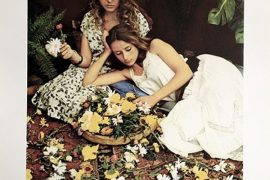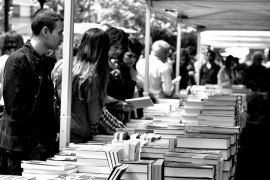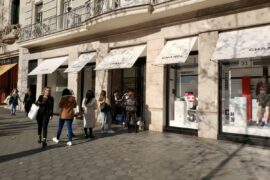[dropcap letter=”A”]
young man, he left a still-walled Barcelona, a city gripped by the ignominy of the Ciutadella—the citadel that dominated the city militarily—but where the spark of revolt and the flames of the Bullanga riots had already been lit. An orphan from a very young age, he had been an apprentice in several trades, from jeweller to shop’s clerk, but he was determined to write, stirred by authors in Castilian Spanish, French and Latin. In the Madrid of Isabel II, he had found himself as a fish in the waters of the political press and café conspiracies. A journalism that in no case was a bargain to bring home the bacon, but rather a guarantee to end up being censorship or prison fodder.
 In the Villa y Corte—the Madrid of government and royal court—he got a taste of Bohemian misery, the rigour of censorship and the humiliation of prison, from which he continued to write feverishly, articles and novels, but emerged sick from tuberculosis. As a parliamentary chronicler—one of the creators of the genre in Spain—of the political divisions in the democratic camp in which he enrolled once again left him at the gates of misfortune. Perhaps to recover, he returned to his city which had by then cast off its walls and now dreamt of growing with its Eixample—the grid-patern district expanding the city. It was then, between 1865 and 1866, when the journalist Robert Robert had enough with just twenty-seven articles published in Catalan in the magazine Un Tros de Paper—A Piece of Paper—to create a tradition, and almost a language model.
In the Villa y Corte—the Madrid of government and royal court—he got a taste of Bohemian misery, the rigour of censorship and the humiliation of prison, from which he continued to write feverishly, articles and novels, but emerged sick from tuberculosis. As a parliamentary chronicler—one of the creators of the genre in Spain—of the political divisions in the democratic camp in which he enrolled once again left him at the gates of misfortune. Perhaps to recover, he returned to his city which had by then cast off its walls and now dreamt of growing with its Eixample—the grid-patern district expanding the city. It was then, between 1865 and 1866, when the journalist Robert Robert had enough with just twenty-seven articles published in Catalan in the magazine Un Tros de Paper—A Piece of Paper—to create a tradition, and almost a language model.
“The prose by this man really has a certain effect and some of his writing, like La rebotiga—the Shop Storeroom, is amongst the best things written in Catalan here at the time of what we call Renaixença—the Catalan Renaissance, a very difficult time and therefore much appreciated.” The word of Pla in his El quadern gris—The Grey Notebook.
If anyone has any doubt about Robert Robert’s legacy to Catalan journalism, that written in the language, three giants of 20th century Catalan literature, Josep Carner, Carles Riba and Josep Pla—then three novices straddling the Catalan Noucentisme cultural movement and Post-Noucentism—attest to it: at the turn of 1920, the “Prince of poets” Carles Riba takes him on as a writer for the Editorial Catalana—the publishing house fostered by Prat de la Riba’s (no relation) Lliga conservative party, backed economically by Francesc Cambó and in which he was the literary director—with a selection of prose for Un Tros de Paper he entrusts Riba with. It is in this context, with Riba in charge, that Josep Pla learns of him: “These days I have read the little volume published by the Biblioteca Popular L’Avenç—issue number 73—with a piece by Robert Robert titled Barcelonines. The prose by this man really has a certain effect and some of his writing, like La rebotiga—the Shop Storeroom, is amongst the best things written in Catalan here at the time of what we call Renaixença—the Catalan Renaissance, a very difficult time and therefore much appreciated”. The word of Pla in his El quadern gris—The Grey Notebook.
Born in Barcelona in 1830, writer, journalist and politician Robert Robert i Casacuberta could hardly imagine that he would be remembered by the generation of his grandchildren and to this day, almost exclusively for these few articles written in Catalan, and not for the enormous production written exclusively in Castilian Spanish. A member of that generation of Catalans who proposed the moral, economic and political conquest of Spain—statesman and general Joan Prim was born in Reus in 1814, writer and politician Víctor Balaguer was ten years younger—democrat Robert clearly represents the option by men of letters of Catalan birth who believe, in good faith, in renouncing their own culture and language in order to create major works in Castilian Spanish, linked to their peninsular political project. This resignation did not prevent them from participating enthusiastically at the same time in the Renaixença that had begun with the poem by another expatriate in Madrid, Bonaventura Carles Aribau.
The novelette El último enamorado, the progressive anticonservative trilogy make up by Los cachivaches de antaño, Los tiempos de Mari-Castaña and La espumadera de los siglos, la satire La corte de Macaronini I—on the arrival of King Amadeus of Savoy—or the anticlerical libel El gran Tiberio del siglo entre luces y pedrades. Jolgorio celebrado en Madrid con motivo del 25º aniversario de Pio IX, must have been for this romantic, writing-mad liberal, a spirit of his time, of greater value than the artefacts in his mother tongue. His stake on Castilian Spanish did not guarantee, however, any glory in Spanish literature—he could cast no shade upon Larra or on Mesonero Romanos, much less on Zorilla, to mention but a few predecessors and contemporaries—but, the publication of this collection of Barcelonese articles has prevented oblivion.
Robert staked on Catalan as it was spoken because he had no references in the scope of the language. His admired Larra could serve as an aesthetic model, but at the linguistic level, he has to do his work alone. He finds his model in the orality of street
BARCELONA PERIOD
In his Barcelona period, during which he is one of the judges of the Jocs Florals—a literary contest that still enjoyed a progressive reputation and had not yet fallen into subsequent stupor—Robert contacts with the Un Tros de Paper group directed by Albert Llanas, who had a flavour of Pitarra’s back storeroom and the populations of Innocenci López, the owner of the Librería Española bookshop. Indeed, Frederic Soler—Pitarra’s true identity—was one of the collaborators, along with Eduard Vidal de Valenciano, Eduard Aulés, Josep Feliu i Codina, Conrad Roure, Frederic Pous, Josep Maria Torres, Francesc Figueres and Manuel Angelon, in the magazine published by López. Robert congregated with his progressive spirit, his wish to contribute to a humour magazine with the aim of reaching and influencing the general public, to try to materialize some awareness in a society increasingly domesticated by bourgeois moral of order and measure, and had put its faith in progress only in material and economic matters.

And in addition, he coincided with the Un Tros de Paper group favouring the use of “Catalan as it is spoken” in the dispute with the zealots of the Jocs Florals—although, as we have seen, the relationships between both groups were more ambiguous than we might think. Robert staked on Catalan as it was spoken because he had no references in the scope of the language. His admired Larra could serve as an aesthetic model, but at the linguistic level, he has to do his work alone. He finds his model in the orality of street, the genuine Catalan of maids and porters, in the apothecaries and amongst the market vendors, what he hears in the Rambla and the back rooms of the shops, the solution to his lack of a model.
“Robert Robert should not be scorned as a writer of prose. He was a man who saw things, a good observer. You cannot, in any case, ignore or minimize the moment: 1865-1866. At that time, the influence of Castilian Spanish is still absolute. Pitarra is attacked by the major papers of Barcelona, as the quintessence of vulgarity. Society—Castilianized—thought itself different. No, no, Robert Robert is a considerable writer who wrote prose that was certainly outlandish but very important, prior to poet and priest Jacint Verdaguer’s vital itinerary. Two very different things, certainly, but for today’s tastes, the more vulgar descriptions by Robert are much more interesting than Verdaguer’s rhetorical clichés,” says Josep Pla upon comparing Dietari d’un pelegrí a Terra Santa—Diary of a pilgrim to the Holy Land—by Jacint Verdaguer,” the best book of Catalan prose of the last century,” with the articles by Robert in Un Tros de Paper.
On the subject of costumbrism, it has been precisely this damned epithet that has been taken to describe Robert’s and his contemporaries or disciples too often, reducing them to minor, anecdotal, domestic or folkloric forms, in the face of the great epic or lyrical literature
Pla—like Carner or like Sagarra—also began his career in prose from journalism. However, he does not begin anew like Robert, who is a child of a tradition lacking the Catalan language that has only just been ordered under the aegis of grammarian Pompeu Fabra, where official life is being Catalanized by the Mancomunitat—the Catalan Commonwealth autonomous government—but where newspapers are still largely written in Spanish, when looking for references—a difficult task—which sets Robert Robert at the top: he is the link that connects the generation of the twenties and thirties with the European tradition. This tradition begins with English journalism at the beginning of the 18th century—Catalonia then, in the middle of the War of Succession or of its aftermath, had no time for trifles, certainly not for essayistic journalism in the manner of Adisson in The Tatler or The Spectator or like Daniel Defoe’s pamphlets, and the language had withdrawn to the private rooms of the Baró de Maldà. The tradition then passes through the French moralists, which Josep Pla admired, and is related to the romantic costumbrism—novels describing every day life—by Madrid’s Larra. From Larra, Robert takes the combination of description, short essay, dialogue and the tone of conversation with the reader, clearly evident in Robert’s articles. A key tradition in European literature, which Pla is forced to fabricate, even taking Robert, inventing it if necessary, to explain his literature. Before other proposals, Carner, Sagarra and Pla take Robert’s path and imitate, or directly plagiarize him, as Professor Ferran Toutain has observed.
On the subject of costumbrism, it has been precisely this damned epithet that has been taken to describe Robert’s and his contemporaries or disciples too often, reducing them to minor, anecdotal, domestic or folkloric forms, in the face of the great epic or lyrical literature. Robert is not a nostalgic of the old city, nor a historicist in the way of L’orfeneta de Menargues o Catalunya agonisant by Antoni de Bofarull—the first novel in Catalan of the Renaixença, published in 1862—but a city dweller, a stroller, a quidnunc, a child of the city. And here it is worth remembering that while in Barcelona the works begin on the Eixample—the Ensanxe as Robert refers to and observes—the Paris of Napoleon III sees the great renovations being carried out by Baron Haussmann, from which the figure of Charles Baudelaire’s flâneur will appear.
“Barcelona, gay, leisurely, dynamic Barcelona, do not search for it but in the Passeig de Gràcia, and now more than ever since the development of the Ensanxe, damn the word! The Passeig de Gràcia is more boulevard than the Rambla,” writes Robert Robert
The streets where Robert strolls are the same Ramblas and the same Passeig de Gràcia his “grandchildren”will speak of, but between then and now will have passed a Universal Exhibition of Barcelona, the development of the Eixample—with some of the streets just being named at the time of Robert, at the proposal of Víctor Balaguer—the aggregation of the surrounding villages—Sants, Les Corts, Sant Gervasi de Cassoles, Gràcia, Sant Andreu de Palomar and Sant Martí de Provençals, plus Sant Joan d’Horta, and the last of them all, Sarrià—the opening of Via Laietana, with the disappearance of a good part of the old Barcelona under the Reformation project, and the plans for a new exhibition in Montjuïc, finally inaugurated in 1929.
In between, names like Lluís Domènech i Muntaner, Josep Puig i Cadafalch and Antoni Gaudí compete to build their memorable houses on the Passeig de Gràcia, about which Robert writes: “Barcelona, gay, leisurely, dynamic Barcelona, do not search for it but in the Passeig de Gràcia, and now more than ever since the development of the Ensanxe, damn the word! The Passeig de Gràcia is more boulevard than the Rambla, because it is much wider; because it has more open, enjoyable views; thanks to the buildings now beginning to border it. They do not remind one, as do those on the Rambla, of the punishment of work and the greed of industry, but the pleasant rest, the well-being, the wealth and the luxury.” This boulevard, where the first buildings are just beginning to be put up in accordance with the ideas of Cerdà—whose plan will soon be betrayed—“offers us the view of semi-circle of the surrounding hills that guard a delicious plain, sometime covered with green wheat and red poppies, other times gilded by the bright straw stubble.” In any case, this still rural walk is full of “People who come, people who go, people who come and go,” and has already become the favourite place to see and be seen.
“La Rambla, like everything in Spain, always starts with priests and ends with soldiers,” writes Robert
Further down, on the Rambla—or the four Rambles: the clerical Capellans, to the current Caneletes; the cheerful Rambla de les Flors; the cosmopolitan and intellectual del Mig and the military de Santa Mònica—Robert writes “The special character of each of the four Rambles or part of the Rambla has lasted long and will last as long as the street stays the centre of Barcelona, just as much the centre for those who live in the incipient Ensanxe as for those who were born and have lived all their lives at the Padró or the Pla de Palau. La Rambla, like everything in Spain, always starts with priests and ends with soldiers.” In other words, what appears to be a wholly costumbrist article, Robert ends a phrase that is all metaphor about the politics of his time.
In fact, this totally ideological mordacity that points to the end of one of the most lively and apparently costumbrist articles of the twenty-seven published by Robert in Un Tros de Paper is typical of a writer who has earned a living and prestige in the political struggle and considers writing as a tool in the fight for progress and freedom in Spain’s convulsed Eighteen Hundreds. In Ai, que han mort un noi!—Oh, They’ve Killed a Boy!—the writer attacks the manipulation of the masses raised in revenge of a non-existent death—which seems to distantly resonate with a story by modern author Quim Monzó, who would be one of the last epigones of the lacking tradition started by Robert. Meanwhile El ball d’en Serrallonga—Serralonga’s Dance, serves in contrast to attack the conservatives who once again miss the world of the Old Regime: “those stubborn times in which they hanged and quartered vassals who today sell vinegar as a gift of God, and they mean to make us believe that all that is new is bad. El ball d’en Serrallonga means that in that time such sorry folk found to be in good taste what today we find disgusting. It means convents and tithes, mals usos—evil customs, streets without lighting, provinces without paths or post, and four-wick lamps; it means that, before the law, the idle are people and the laborious are swine. It means being hung, beheaded and quartered, tongue pulled though gullet; It means monkey and snake and cat, inside the criminal boot… And they expect me not to be glad to see it?”.
Death came to him just when he had been appointed the plenipotentiary minister before the Swiss Confederation by the republican government. But he would never make it to Switzerland.
The liberal broadside continues with Uns hòmens de bé—Good, Honest Men, where he portrays those gentlemen as “savers, homely, religious, whatever they like,” but they “are villains from head to toe.” Revived lice, children of illiterate labourers or washerwomen, but with enough ingenuity to rise and despise the world they come from, selfish, conservative, anti-liberal and anti-political, who complain of material progress while “travelling by steamer, use gas, have railway shares, and as soon as they can, they found a credit or insurance company.” A ridicule of a certain kind of petty-bourgeois that seems like an ancestor of Catalan author Rusiñol’s archetypal Sr. Esteve, for whom Robert’s contemporary would not refrain from wanting “a return the old forms of government,” when they would be treated to kicks in the backside by the nobles and fed the soups of friars—clear, watery soup.
Nosey neighbours, little love stories, fondness for swimming, the nascent habit of spending the weekend at their torreta—a chalet, at El Putxet, now a high-standing district of Barcelona, the art of choosing a melon, different kinds of widower, or costume parties, are also essential literary material in moralizing but cheerful articles, crossed however by the shadow of death. Yes, the death caused by the cholera that, despite the humour, cuts our laughter short just thinking that in just two months the epidemic harvested 4,000 victims in Barcelona alone. Every house counts its dead, the city is deserted, shops, cafes, theatres, everything is closed, the workers out of work, and despite it all, the Un Tros de Paper group finds the strength to continue publishing the magazine. Robert came out alive from the evil that infested his city, and he soon returned to Madrid where he became very much involved in the conspiracies that led to the dethronement of Isabel II—the queen he had ridiculed in Quisicosas del rey y la reina—Conundrums of King and Queen, published in El Tío Crispín, for which he was sentenced to prison, the so-called Glorious Revolution of September, the brief reign of Amadeus I and the First Republic. Death came to him just when he had been appointed the plenipotentiary minister before the Swiss Confederation by the republican government. But he would never make it to Switzerland.



















